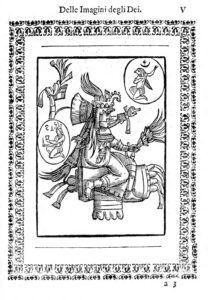 The Paduan antiquarian Lorenzo Pignoria composed a small treatise on the gods of different parts of the world as an appendix to Vincenzo Cartari’s famous mythographic work. Pignoria’s Aggionta, compiled in three editions starting in 1615, constituted a new way of observing and interpreting polytheistic gods that was no longer based on apologetic scriptural exegesis but ascribed a new documentary value to objects and images. Pignoria collected information on the gods of different parts of the world from disparate sources. Regarding the gods of Mesoamerica, the antiquarian relied on data and depictions from a colonial pictorial codex preserved in the Vatican Apostolic Library, the Codex Vat. Lat. 3738, produced between 1562 and 1566 in New Spain and sent to Rome as a gift, probably by the Dominican friar Juan de Córdoba. By the 1580s, the codex had aroused the antiquarian interest of a network of intellectuals, including Michele Mercati, Philips van Winghe, Nicolas-Claude Fabri de Peiresc, and Pignoria himself. The images of Codex Vat. Lat. 3738 gave rise to a fruitful intellectual “experiment” in which the antiquarian culture explored the possibilities of an global and comparative theory of religion based on innovative visual criteria.
The Paduan antiquarian Lorenzo Pignoria composed a small treatise on the gods of different parts of the world as an appendix to Vincenzo Cartari’s famous mythographic work. Pignoria’s Aggionta, compiled in three editions starting in 1615, constituted a new way of observing and interpreting polytheistic gods that was no longer based on apologetic scriptural exegesis but ascribed a new documentary value to objects and images. Pignoria collected information on the gods of different parts of the world from disparate sources. Regarding the gods of Mesoamerica, the antiquarian relied on data and depictions from a colonial pictorial codex preserved in the Vatican Apostolic Library, the Codex Vat. Lat. 3738, produced between 1562 and 1566 in New Spain and sent to Rome as a gift, probably by the Dominican friar Juan de Córdoba. By the 1580s, the codex had aroused the antiquarian interest of a network of intellectuals, including Michele Mercati, Philips van Winghe, Nicolas-Claude Fabri de Peiresc, and Pignoria himself. The images of Codex Vat. Lat. 3738 gave rise to a fruitful intellectual “experiment” in which the antiquarian culture explored the possibilities of an global and comparative theory of religion based on innovative visual criteria.
About the speaker
Sergio Botta is an Associate Professor in the History of Religions at the Department of History, Anthropology, Religions, Arts and Performing Arts (Sapienza University of Rome). His main research interests are Indigenous Religions of the Americas (especially Mesoamerica), Method and Theory in the Study of Religions, and Religions and Arts. Currently, he is working on a monograph about the Franciscan discourse regarding Mesoamerican gods in XVI-century New Spain. Also, he is working (with Guilhem Olivier) on a new edition of the Codex Vat. Lat. 3738 (also known among americanists as Códice Vaticano A o Ríos). He is the Deputy Editor of the journal Studi e Materiali di Storia delle Religioni. Among his books: Le acque preziose. Saggio sui sistemi religiosi mesoamericani (2004); La religione del Messico antico (2006); Religione e Conquista. Saggi sul discorso coloniale in Messico (2008); Cinema e religioni (with E. Prinzivalli) (2010); Manufacturing Otherness: Missions and Indigenous Cultures in Latin America (2013); Acerca de la (des)memoria y su construcción en Mesoamérica y Andes (with C. Battcock) (2014); Le Religioni e le Arti. Percorsi interdisciplinari in età contemporanea (with T. Canella) (2015); Corpi sciamanici. La nozione di persona nello studio dello sciamanesimo (with M. Ferrara) (2018); Dagli sciamani allo sciamanesimo. Discorsi, credenze, pratiche (2018).

